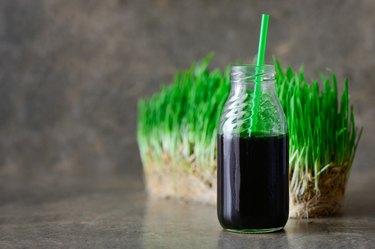
Chlorophyll is a chemical found in plants that converts the sun's rays into food, and some people believe it has benefits for humans, too. If you believe the hype, liquid chlorophyll is supposed to detox the body, "clarify" the blood, prevent cancer and help with weight loss.
But studies have been mixed on how effective drinking liquid chlorophyll really is for any health benefit.
Video of the Day
Video of the Day
Is Chlorophyll Safe to Drink?
Chlorophyll is considered nonpoisonous, according to the U.S. National Library of Medicine (NLM), and drinking it isn't likely to result in any symptoms. But it can be harmful in large amounts.
If you're thinking about jumping on the trend, here's what you should know about the risks and side effects of liquid chlorophyll, per the NLM:
1. Diarrhea
Although rare, swallowing chlorophyll can lead to loose stools for some people. And you might notice a strange color in the toilet bowl (more on that in a minute).
These loose stools should go away within a day or so. If they don't, you should call your doctor.
2. Stomach Cramps
Along with diarrhea, some people report experiencing stomach cramps as a side effect of drinking liquid chlorophyll.
While stomach cramps aren't necessarily dangerous, they can certainly be uncomfortable. And as with diarrhea, if they don't go away within a day or two, you should call your doctor.
3. Discolored Tongue, Urine and Stool
Drinking chlorophyll can temporarily change the color of your pee and poop, giving them a greenish hue. It can also turn your tongue black or yellow.
While odd, these changes aren't harmful, and they shouldn't last long.
4. Burning or Itching
Many people choose to drink liquid chlorophyll, but some people apply it to wounds (there's no evidence that this is helpful).
If chlorophyll comes into contact with your skin, it may cause a mild itching or burning sensation.
Warning
If you have any of these symptoms after drinking liquid chlorophyll, go to the emergency room or call the Poison Help hotline at 1-800-222-1222. Symptoms generally resolve on their own, but again, chlorophyll can be harmful in large amounts.
Keep in Mind: Supplements Can Be Risky
Liquid chlorophyll is a dietary supplement, and the U.S. Food & Drug Administration (FDA) does not make sure supplements are safe or effective before they hit store shelves.
So, while there aren't many serious risks of liquid chlorophyll in small doses, there's no guarantee that a chlorophyll supplement contains only that ingredient or includes the amount of chlorophyll stated on the bottle or packaging. There could be other ingredients in the supplement that may cause side effects, or there could be much more chlorophyll in the supplement than you realize, which could lead you to drink too much.
Cancer and Chlorophyll
Some research has suggested that chlorophyll can help fight cancer.
In a July 2018 research article in the Journal of Oxidative Medicine and Cellular Longevity, for example, researchers found that chlorophyll decreased pancreatic cell viability and reduced pancreatic tumor size in mice.
This was based on experiments done on mice, though, not humans, and the researchers didn't conclude that people with cancer should drink liquid chlorophyll. Instead, they said this supports the idea that eating chlorophyll-rich green vegetables has health benefits.
Weight-Loss Benefits of Chlorophyll
Like the research around cancer and chlorophyll, studies about weight loss and chlorophyll have mostly looked at the effect of chlorophyll-rich green vegetables.
September 2013 and June 2014 studies in the Journal of Appetite found that chlorophyll helps to reduce total and LDL ("bad") cholesterol, as well as sweet and unhealthy food cravings and overall caloric intake.
Also, when chlorophyll-rich green plant membranes were added into people's diets, researchers saw a reduction in waist circumference, body fat and leptin, a hormone that helps regulate body weight. While leptin is known for its ability to inhibit hunger, when there's a reduction in body fat, a reduction in leptin naturally follows suit, which is the case here.
What Are the Best Chlorophyll Supplements?
There are risks to getting chlorophyll — or any nutrient — through supplements, as we noted above. So the healthiest way to get a dose of chlorophyll? By eating green vegetables.
Some chlorophyll-rich foods include:
- Spinach
- Kale
- Collard and mustard greens
- Lettuce
- Broccoli
- Asparagus
- Peas
- Green beans
If you are unable to get enough chlorophyll through vegetables in your diet for medical reasons, talk to your doctor about whether supplementing is a good idea for you.
- U.S. National Library of Medicine: “Chlorophyll”
- Oregon State University Liunus Pauling Institure: “Chlorophyll and Chlorophyllin”
- National Library of Medicine: “Supplementation by Thylakoids to a High Carbohydrate Meal Decreases Feelings of Hunger, Elevates CCK Levels and Prevents Postprandial Hypoglycaemia in Overweight Women”
- National Library of Medicine: “Body Weight Loss, Reduced Urge for Palatable Food and Increased Release of GLP-1 Through Daily Supplementation With Green-Plant Membranes for Three Months in Overweight Women”
- Journal of Oxidative Medicine and Cellular Longevity: "Chlorophyll-Mediated Changes in the Redox Status of Pancreatic Cancer Cells Are Associated with Its Anticancer Effects"
- U.S. Food & Drug Administration: "What You Need to Know about Dietary Supplements"
- Journal of Appetite: "Supplementation by thylakoids to a high carbohydrate meal decreases feelings of hunger, elevates CCK levels and prevents postprandial hypoglycaemia in overweight women"
Is this an emergency? If you are experiencing serious medical symptoms, please see the National Library of Medicine’s list of signs you need emergency medical attention or call 911.